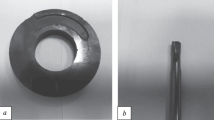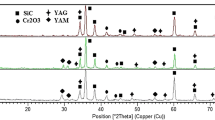The main production defects typical for ceramic-matrix composites (CMC) with an SiC matrix prepared by liquid-phase siliciding are formulated: bulk and surface CMC cementation, nonuniformity of the siliciding process, degradation of carbon and SiC fibers due to molten Si, the presence of microcracks, open and closed pores, and internal cracking and swelling of the final CMC. Reasons for their occurrence are analyzed and it is shown that most of the defects are the result of complex physicochemical and thermophysical phenomena accompanying the basic modifications of this technology. Practical recommendations are formulated for the main production defects to prevent them or minimize their impact on the operational characteristics of the final material. The requirement for special studies to optimize the composition of semi-finished products and regimes for all stages of the production processes with the aim of preparing CMC with minimum defects and the best performance properties is demonstrated










Similar content being viewed by others
References
A. P. Garshin, V. I. Kulik, S. A. Matveev, and A. S. Nilov, “The state-of-art technologies for the fiber-reinforced composition materials with the ceramic refractory matrix (Review),” Refract. Ind. Ceram., 58(2), 148 – 161 (2017).
GOST R 56465–2015. Cosmic systems. Nonmetallic materials based on ceramic matrix and carbon-carbon composite materials, used within the composition of low thrust liquid rocket engines( orientation and correction of pulses). Classification. Nomenclature of Indices.
W. Krenkel, “Carbon fiber reinforced CMC for high performance structures,” International Journal of Applied Ceramic Technology, 1(2), 188 – 200 (2004).
H. A. El-Hija, W. Krenkel, and S. Hugel, “Development of C / C–SiC brake pads for high-performance elevators,” International Journal of Applied Ceramic Technology, 2(2), 105 – 113 (2005).
B. Li, L. Cheng, L. Yu, et al., “Low-cost preparation and frictional behaviour of a three-dimensional needled carbon / silicon carbide composite,” J. Eur. Ceram. Soc., 29(3), 497 – 503, (2009).
S. V. Stankus, R. A. Khairulin, and P. V. Tyagel’skii, “Thermal properties of germanium and silicon in a condensed condition,” Teplofiz. Vysok. Temp., 37(4), 559 – 564 (1999).
A. B. Elakov, “Development of technology for preparing carbon-carbon composite material based on unwoven oxidized polyacrylonitrile,” Diss. Cand. Techn. Sci., Korolev (2018).
V. I. Kulik, A. S. Nilov, A. P. Garshin, et al., “The investigation of tribotechnical characteristics for composites based on carbide-silicon matrix,” Refract. Ind. Ceram., 53(4), 259 – 268 (2012).
A. P. Garshin, V. V. Karlin, G. S. Oleinik, and Ostroverkhov, Structural Silicon Carbide Materials [in Russian], Mashinostroenie (Leningrad section) (1975).
J. Mentz, M. Muller, H.-P. Buchkremer, D. Stover, “Processing of porous C/SiC via siliconizing,” Proc. of International Conference on Carbon Materials “Carbon’01”, Lexington, Ky, 14 – 19 July 2001. https://acs.omnibooksonline.com/data/papers/2001_31.3.pdf.
A. E. Ershov, S. L. Shikunov, and V. N. Kurlov, “ Method for calculating the phase composition of SiC-Si-C-materials prepared by siliciding carbon matrices,” Zh. Tekhn. Fiz., 87(6), 888 – 895 (2017).
E. I. Karamenko, V. V. Kulakov, A. M. Kenigfest, et al., Preparation and properties of friction carbon-ceramic materials of the C/SiC class,” Izv. Samara Sci. Center of the Russian Academy of Sciences,13, No. 4(3), 759 – 764 (2011).
V. I. Kostikov, N. M. Chernenko, and I. I. Sidorov, “Bases of carbon silicon carbide composite technology for objects under extreme operating conditions,” Proc. 3rd Internat. Conf. “Materials and coatings under extreme conditions,” 13 – 17 Sept. 2004, Katsiveli, Ukraine (2004).
V. V. Vasil’ev, V. D. Protasov, V. V. Bolotin, et al., Composite Materials: Handbook [in Russian], Mashinostroenie, Moscow (1990).
G. S. Corman and K. L. Luthra; ed. by P. Narottam and G. S. Corman, Silicon Melt Infiltrated Ceramic Composites (HiPerCompTM); In: Handbook of Ceramic Composites, Kluver Academic Publishers, Bansal, Boston, Dordrecht, London (2005).
S. L. Shukunov and V. N. Kurlov, “Preparation of composite materials based on silicon carbide with carbon matrix siliciding,” Zh. Tekhn. Fiz., 87(12), 1871 – 1878 (2017).
J. Magnant, L. Maillé, R. Pailler, et al., “Carbon fiber/reaction-bonded carbide matrix for composite materials — manufacture and characterization,” J. Eur. Ceram. Soc., 32(16), 4497 – 4505 (2012).
V. V. Molchanov, M. N. Shchukin, V. I. Zaikovskii, et al., “Sorbents and carriers based on nano[porous carbon xerogels,” Kinetika Kataliz., 49(5), 734 – 740 (2008).
M. Muller, J. Mentz, P. H. Buchkremer, and D. Stover, “Origin and effect of fiber attack for the processing of C/SiC,” in: High Temperature Ceramic Matrix Composite, W. Krenkel [et al.] (eds). (2001).
A. P. Garshin, V. I. Kulik, and A. S. Nilov, “Main areas for improving refractory fiber-reinforced ceramic matrix composite corrosion and heat resistance (Review),” Refract. Ind. Ceram., 58(6), 673 – 682 (2018).
N. I. Baklanova, “Interface coatings on reinforcing carbon and silicon carbide fibers for composites with a ceramic matrix,” Diss. Doct. Chem. Sci., Novosibirsk (2011).
K. Kobayashi, K. Maeda, H. Sano, and Y. Uchiyama, “High temperature oxidation of carbon/SiC/B4C composite in different atmospheres,” Tanso, 151, 20 – 26 (1992).
V. I. Kulik and M. S. Ramm, RF Patent 2337083, Method for preparing fiber-reinforced silicon carbide composite material, Claim 06.07.06; Publ. 10.27.08, Bull. No. 30.
W. Krenkel and N. Langhof, “Ceramic matrix composites for high performance friction applications,” In Proceedings of the IV Advanced Ceramics and Applications Conference (2017).
I. L. Sinani, V. M. Busuev, and S. E. Buguzov, RF Patent 2480433, Method for preparing sealed components made from silicon carbide material, Claim 07.08.11; Publ. 04.27.13, Bull No. 12.
I. A. Porodzinskii, “High density silicon carbide material with regular phase composition,” Diss. Cand., Techn. Sci., Moscow (2015).
I. L. Sinani, V. M. Bushuev, and S. E, Butuzov, RF Patent 2471707, Method for preparing sealed objects made of carbon-carbon or carbon silicon carbide composite material, Claim 01.2011; Publ. 01.10.13, Bull. No. 1
K. W. Nam, “Effect of crack healing of SiC according to times of SiO2 colloid coating,” Journal of Powder Technology, Article ID 695895 (2013).
R. S. Goller, B. Mauri, and M. Orlandi, WO Patent 2008/007411. Braking band composite structure of a brake disk; Publ. 01.17.2008.
C. Courtois, J. Desmaison, and H. Tawil, “Protection against oxidation of C/SiC composites: oxidation behaviour of CVD TiB2 coated substrates,” Journal de Physique IV Colloque, 3, 843 – 853 (1993).
A. S. Fialkov, Carbon Interlayer Compounds and Composites Based on Them [in Russian], Aspekt Press, Moscow (1997).
Author information
Authors and Affiliations
Corresponding author
Additional information
Translated from Novye Ogneupory, No. 8, pp. 23 – 33, August, 2019.
Rights and permissions
About this article
Cite this article
Garshin, A.P., Kulik, V.I. & Nilov, A.S. Analysis of Occurrence, Properties, and Methods of Minimizing Production Defects in Ceramic Composites with an Sic-Matrix Prepared by Liquid-Phase Siliciding. Refract Ind Ceram 60, 376–384 (2019). https://doi.org/10.1007/s11148-019-00371-5
Received:
Published:
Issue Date:
DOI: https://doi.org/10.1007/s11148-019-00371-5




